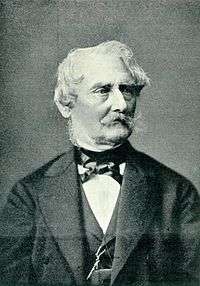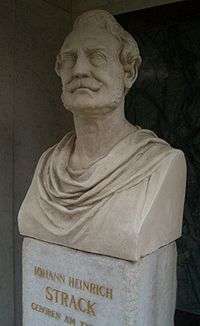Heinrich Strack


Johann Heinrich Strack (6 July 1805, Bückeburg - 13 June 1880, Berlin) was a German architect of the Schinkelschule. His notable works include the Berlin Victory Column.
Life
Heinrich was the son of the portrait and landscape painter Anton Wilhelm Strack (1758–1829) and a sister of the painter Johann Heinrich Tischbein the elder. Johann studied at the Berlin Bauakademie on and off from 1824 to 1838. There he passed various exams (1825 Feldmesserprüfung, 1827 Kondukteurprüfung, 1837/38 Baumeisterprüfung). In the breaks in study, among other things, he took a two-year apprenticeship in the studio of Karl Friedrich Schinkel, a trip to Saint Petersburg with Friedrich August Stüler and several private architectural commissions. He was close friends with Stüler and also travelled with him to England and France as well as constructing or completing some of his buildings, such as the Alte Nationalgalerie from 1866 to 1876 after Stüler's death.
In 1841 he was appointed a professor at the Prussian Academy of Arts, where he had been a teacher since 1839. From 1842 he served in the Hofbauamt and in 1850 he joined the Baudeputation and Hofbaurat. In 1854 he was appointed a professor at the Berlin Bauakademie and in 1862 he carried out excavations in Athens with Ernst Curtius and Karl Bötticher. In 1876 Wilhelm I made Strack "Kaiser's architect", which also marked his transition to retirement.
Selected works
- 1845–1849: Babelsberg Palace, completion after the death of Ludwig Persius
- 1854: Refurbishment of the Old Palace, Unter den Linden, Berlin
- 1853–1856: St. Andrew's Church, formerly Stralauer Platz, Friedrichshain
- 1856–1858: Expansion of the Kronprinzenpalais, Unter den Linden, Berlin
- 1867–1868: Gatehouses of the Brandenburg Gate
- 1869–1873: Berlin Victory Column, now in Großer Stern in the Tiergarten in Berlin
- 1866–1875: Construction of the Alte Nationalgalerie, Berlin
- 1853–1856: Flatow Tower in Babelsberg Park
- 1870/1871: Redesign of the Berlin Gerichtslaube in the park of Babelsberg Palace
Sources
| Wikimedia Commons has media related to Johann Heinrich Strack. |